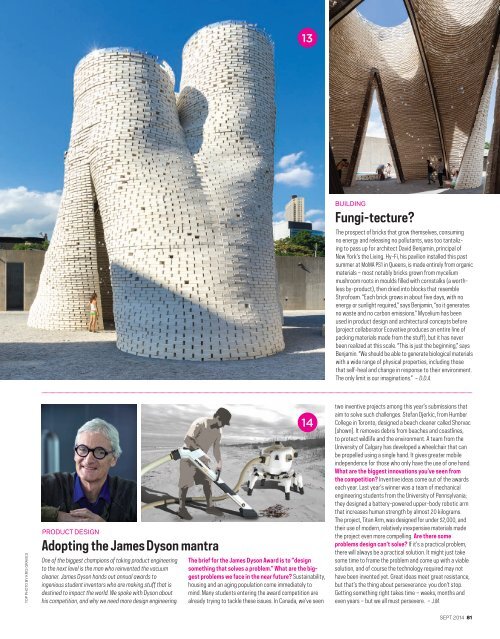AZURE_2014_09.pdf
Create successful ePaper yourself
Turn your PDF publications into a flip-book with our unique Google optimized e-Paper software.
13<br />
building<br />
Fungi-tecture?<br />
The prospect of bricks that grow themselves, consuming<br />
no energy and releasing no pollutants, was too tantalizing<br />
to pass up for archi tect David Benjamin, principal of<br />
New York’s the Living. Hy-Fi, his pavilion installed this past<br />
summer at MoMA PS1 in Queens, is made entirely from organic<br />
materials – most notably bricks grown from mycelium<br />
mushroom roots in moulds filled with cornstalks (a worthless<br />
by-product), then dried into blocks that resemble<br />
Styrofoam. “Each brick grows in about five days, with no<br />
energy or sunlight required,” says Benjamin, “so it generates<br />
no waste and no carbon emissions.” Mycelium has been<br />
used in product design and architectural concepts before<br />
(project collaborator Ecovative produces an entire line of<br />
packing materials made from the stuff), but it has never<br />
been realized at this scale. “This is just the beginning,” says<br />
Benjamin. “We should be able to generate biological materials<br />
with a wide range of physical properties, including those<br />
that self-heal and change in response to their environment.<br />
The only limit is our imaginations.” – D.D.A.<br />
top photo BY kris graves<br />
product design<br />
Adopting the James Dyson mantra<br />
One of the biggest champions of taking product engineering<br />
to the next level is the man who reinvented the vacuum<br />
cleaner. James Dyson hands out annual awards to<br />
ingenious student inventors who are making stuff that is<br />
destined to impact the world. We spoke with Dyson about<br />
his competition, and why we need more design engineering.<br />
14<br />
The brief for the James Dyson Award is to “design<br />
something that solves a problem.” What are the biggest<br />
problems we face in the near future? Sustainability,<br />
housing and an aging population come immediately to<br />
mind. Many students entering the award competition are<br />
already trying to tackle these issues. In Canada, we’ve seen<br />
two inventive projects among this year’s submissions that<br />
aim to solve such challenges. Stefan Djerkic, from Humber<br />
College in Toronto, designed a beach cleaner called Shorvac<br />
[shown]. It removes debris from beaches and coastlines,<br />
to protect wildlife and the environment. A team from the<br />
University of Calgary has developed a wheelchair that can<br />
be propelled using a single hand. It gives greater mobile<br />
independence for those who only have the use of one hand.<br />
What are the biggest innovations you’ve seen from<br />
the competition? Inventive ideas come out of the awards<br />
each year. Last year’s winner was a team of mechanical<br />
engineering students from the University of Pennsylvania;<br />
they designed a battery-powered upper-body robotic arm<br />
that increases human strength by almost 20 kilograms.<br />
The project, Titan Arm, was designed for under $2,000, and<br />
their use of modern, relatively inexpensive materials made<br />
the project even more compelling. Are there some<br />
problems design can’t solve? If it’s a practical problem,<br />
there will always be a practical solution. It might just take<br />
some time to frame the problem and come up with a viable<br />
solution, and of course the technology required may not<br />
have been invented yet. Great ideas meet great resistance,<br />
but that’s the thing about perseverance: you don’t stop.<br />
Getting something right takes time – weeks, months and<br />
even years – but we all must persevere. – J.M.<br />
sept <strong>2014</strong> 81


















